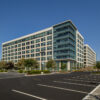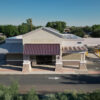There are a few parts of a commercial lease that you should pay close attention to. Commercial leases are lengthy documents that can be seriously daunting to peruse, but it’s important that you take the time to read all of the terms carefully before signing on the dotted line. While every part of the lease document is important, the following terms of the standard commercial lease contract are areas where you need to pay particularly close attention.
Four Important Parts of a Commercial Lease
1. Length of the Lease
The length of your lease is incredibly important for your business. A longer lease can often secure a lower monthly rent, as landlords prefer to have tenants locked into place to reduce the need to renegotiate or fill vacant spaces frequently; however, if you anticipate your business needs changing in the near future, a shorter lease may be preferable. You don’t want to end up having unused square footage or having to pay costly fees to break your lease if you need to relocate. Having a sublease term can be beneficial if you do opt for a long-term lease because you will have the ability to rent out any unused portion of your space if your business changes before your lease expires.
2. Rent and Security Deposit Terms
Of course, the area that discusses how much you’ll be expected to pay is an important part of your loan. Don’t just look at what the monthly rental rate is. Take the time to find out if and when rent increases and what the maximum amount of the increase will be. You should also look for information about any fees you may be assessed in addition to rent, what portion of operating costs are passed along to you as the tenant and what allowances are made for improvements to the space.
Pay attention to the security deposit, too. In some cases, you can negotiate your way out of having to put any money down to secure your space if you simply provide a letter of credit from a financial institution.
3. Premises Terms
One area of a commercial lease that business owners often mistakenly overlook is the premises terms. This is the area that clearly outlines what you’re renting. If you’re only renting a portion of the building, make sure that the contract includes parking and use of shared areas like any common storage rooms, lobbies, waiting rooms and conference rooms.
4. Use Terms
Use terms outline rules that can be deal breakers for some companies. Check this area to find out if there are any restrictions on what types of business you can conduct. Other tenants in the building may have exclusive clauses in their contract that prevent competitors from being located in the building. These terms could make it impossible for you to expand into other lines of business in the future. In this section of the lease, you’ll also find information about what type of signage and advertising you’re allowed to use on the premises.
Keep in mind that the first draft of your lease is likely to have terms that are most favorable for the landlord, but you do not have to simply agree. Landlords expect a negotiation to take place, so don’t be afraid to make a case for improving the terms to bring the contract into a better balance to benefit the both of you.
Investing In Commercial Real Estate?
Looking to invest in Arizona Commercial Real Estate? At ICRE Investment Team, we work with commercial investors, property owners, companies, banks, and commercial loan servicers seeking the highest quality of services in the greater Phoenix, Scottsdale, Mesa and Tempe Arizona regions. Contact us for more information.
















